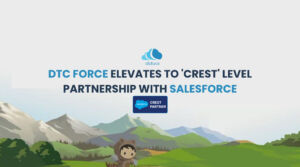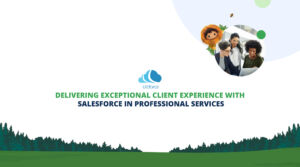Introduction:
In today’s fast-paced business landscape, maintaining meaningful customer relationships is crucial for success. This is where Customer Relationship Management (CRM) software comes into play. In this comprehensive guide, we’ll cover everything you need to know about CRM, from its fundamental concepts to its transformative impact on businesses of all sizes and industries.
1. What is CRM?
CRM, or Customer Relationship Management, is like a toolbox businesses use to track customer interactions. This toolbox includes strategies, practices, and technology. The main goal is to understand customers better and make them happier.
Imagine every customer journey, from when they first hear about a company to when they become repeat customers, as a big cycle. CRM helps businesses manage this cycle by organizing all the information about their customers in one place.
This makes it easier for them to communicate with customers and understand their needs.CRM software stores all the details about customers, like their contact information and purchase history, in one central location. This makes it easier for everyone in the company to access and use this information.
However, CRM software does more than just store data. It helps businesses communicate better with customers and leads, leading to happier customers and more sales. It also enables different departments in a company to work together smoothly, like sales, marketing and customer support.
In simple terms, CRM is like the glue that holds everything together in a business when it comes to dealing with customers or leads. It helps companies track who their customers or leads are, what they need, and how to make them happy.
2. Industries and Businesses that Need CRM:
Industries from IT, retail, finance, healthcare, and manufacturing can benefit from CRM. For instance, IT companies use it to automate sales. They use it from prospecting to lead qualifying, segmenting to nurturing, and closing leads to retaining customers.
E-commerce businesses use it to give a personalized shopping experience and repeat sales. Healthcare organizations use it to improve patient care and satisfaction.
You might be a small startup looking for a small business CRM. You aim to build a customer base. Or, you might be a large enterprise. You need an enterprise CRM to strengthen client relationships. It is an essential commodity for companies.
3. Goals of CRM:
The primary objectives include enhancing customer relationships, improving customer experience, increasing revenue, reducing churn rate, and maximizing efficiency. It helps businesses connect with customers deeply.
They can learn about customers’ problems, preferences, and behaviors. Then, they can tailor their strategies. This leads to better outcomes like more repeat sales, cutting marketing costs, and improving customer support.
4. How CRM Works:
CRM systems collect data from various touchpoints, such as emails, phone calls, social media, and website interactions. They give you a full picture of your customers and potential customers, showing what they’ve bought before, what they like, and any problems they’ve had. This data is then organized and analyzed to provide actionable insights.
These systems have tools to help with managing leads, predicting sales, and automating marketing tasks. This helps companies see trends and find chances to grow, like figuring out which products are popular, which areas are promising for business, and which types of customers are worth focusing on.
With all this knowledge, marketing teams can make smart choices, make things run smoother, and help their teams give customers more personalized experiences.
5. How CRM Grows Small Businesses to Large Enterprise Businesses:
Small startups can utilize CRM to nurture leads, track sales activities, and build brand loyalty from the ground up. As businesses scale, it helps manage growing customer bases, streamline operations, and drive revenue.
It serves as a unified platform for large enterprises. They use it to handle complex sales cycles. They run cost-effective personalized marketing campaigns and provide excellent customer service at scale.
6. How does CRM benefit your Business Operations?
1. Centralized Data Management:
- It centralizes all customer data, including contact information, communication history, purchase details, interactions across channels, and touchpoints, making it easily accessible to all departments and providing a 360° view of their leads, customers, or patients.
- This centralized approach streamlines data management processes, eliminating the need for multiple spreadsheets or disparate systems, and ensures data accuracy and consistency across the organization.
2. Sales Process Automation:
- It automates the entire B2B sales funnel and pipeline from prospecting to qualifying, nurturing to meetings, and closing to retaining clients.
- It also automates the B2C sales funnel. This covers the buying journey from touchpoints like website lead capture or PPC ad networks. It automates email nurturing, purchase, and upselling or repeat sales.
2. Improved Communication and Team Collaboration:
- It facilitates seamless communication and collaboration among teams by providing a shared platform for accessing customer information, tracking interactions, and sharing updates in real time.
- This fosters cross-departmental collaboration. It lets sales, marketing, customer service, and other teams work together towards shared goals. This helps them deliver a seamless customer experience.
3. Enhanced Customer Insights:
- Analyzing customer data and interactions provides valuable insights into customer preferences, behavior patterns, and buying habits.
- These insights enable businesses to analyze customer needs, problems, and preferences. Firms use this analysis to shape their offerings and personalize interactions. This leads to higher customer satisfaction scores, loyalty, and advocacy.
4. Boosts Customer Relations:
- Personalized Interactions: It enables customized customer communication based on their preferences and past interactions.
- Higher Satisfaction Scores: Businesses can improve customer satisfaction scores and loyalty by addressing customer needs more effectively.
5. Reduces Churn Rate:
- Targeted Retention Strategies: It allows businesses to identify at-risk customers and implement targeted retention strategies to reduce churn.
- Proactive Engagement: Businesses can proactively address customer concerns and prevent dissatisfaction.
6. Increases Revenue:
- Upselling and Cross-selling Opportunities: It provides insights into customer behavior and purchase history, facilitating upselling and cross-selling opportunities.
- Repeat Business: Nurturing customer relationships and delivering exceptional experiences encourages repeat business and loyalty.
7. Optimizes Marketing Efforts:
- Effective Personalized Marketing: It helps businesses create targeted marketing campaigns based on customer segmentation and behavior analysis.
- Budget Reduction: CRM enables cost-effective marketing strategies by optimizing marketing spend and focusing on high-value prospects.
8. Accelerates Customer Service:
- Streamlined Support Processes: It automates support ticket management and ensures timely resolution of customer issues.
- Improved Efficiency: Support teams can access relevant customer information quickly, leading to faster case resolutions.
9. Data-Driven Decisions:
- Strategic Decision-Making: It equips business leaders with real-time insights and analytics, enabling them to make data-driven decisions. Leaders can access complete reports and dashboards. They can use them to see trends, predict market shifts, and allocate resources well. This helps them drive growth and innovation.
- Enhanced Collaboration and Alignment: It fosters seamless collaboration and alignment across departments, breaking down silos and ensuring everyone is working towards common goals. With a centralized communication and information-sharing platform, leaders can cultivate a culture of teamwork, accountability, and continuous improvement.
7. Top 10 Key CRM Features:
1. Contact Management:
- Centralized Database: It is a centralized repository for storing and managing customer information, including contact details and communication history.
- Segmentation Capabilities: Businesses can segment customers based on various criteria for targeted marketing and personalized communication.
2. Pipeline Management:
- Visual Sales Pipeline: It visually represents the sales pipeline, allowing sales teams to track opportunities at every stage of the sales process.
- Forecasting Tools: Businesses can predict future revenue and make informed decisions through forecasting tools.
3. Lead Scoring:
- Qualification Criteria: It allows businesses to assign scores to leads based on their level of interest and engagement, helping prioritize follow-up efforts.
- Improved Lead Conversion: By focusing on high-scoring leads, sales teams can improve conversion rates and drive revenue growth.
4. Email Integration:
- Seamless Communication: CRM integrates with email platforms, enabling seamless communication and tracking of email interactions within the CRM system.
- Email Campaign Management: Businesses can create and manage email campaigns directly from the CRM platform, ensuring consistent messaging and tracking results.
5. Reporting Analytics:
- Performance Metrics: It offers robust reporting and analytics capabilities, allowing businesses to track key performance metrics such as sales revenue, conversion rates, and customer satisfaction.
- Data Visualization: Businesses can gain insights into trends and patterns to inform strategic decision-making through customizable dashboards and visualizations.
6. Orders, Invoices & Contracts:
- Streamlined Transactions: It helps manage orders, invoices, and contracts in the system. This streamlines the process and ensures accuracy.
- Automated Billing: It automates billing processes, generating invoices and tracking payments for seamless financial management.
7. Field Sales & Service Management:
- Territory Management enables businesses to allocate sales territories and assign leads or accounts to field sales or service representatives for efficient territory management.
- Mobile Accessibility: With mobile CRM capabilities, field sales teams can access customer information, update records, and capture leads on the go.
8. Customer Service Management:
- Ticket Tracking: It provides service management features for tracking customer support tickets, ensuring timely resolution of issues and inquiries.
- Knowledge Base Integration: Integrated knowledge bases within CRM empower customer service agents with relevant information to resolve customer queries effectively.
9. Workflow Automation:
- Automated Processes: It automates repetitive tasks and workflows, such as lead routing, follow-up reminders, and email notifications, improving efficiency and productivity.
- Customizable Workflows: Businesses can customize their CRM and workflows to their specific processes and departments’ needs, optimizing operations and reducing manual effort.
10. CPQ (Configure, Price, Quote):
- Product Configuration: It allows businesses to configure products and services based on customer requirements, ensuring accurate quotes and proposals.
- Pricing Rules: With built-in pricing rules and discounting capabilities, CRM automates pricing calculations and ensures consistency in quoting processes.
8. Types of CRM:
1. Cloud-based CRM:
- Scalability: Cloud-based CRM solutions offer scalability, allowing businesses to quickly scale up or down based on their needs.
- Accessibility: With cloud-based CRM, users can access data and applications from anywhere with an internet connection.
2. On-premise CRM:
- Control and Security: On-premise CRM solutions give businesses greater control over their data and security protocols.
- Customization: On-premise CRM systems offer more extensive customization options to tailor the software to specific business requirements.
3. Industry-specific CRM:
- Niche Market Focus: Industry-specific CRM solutions cater to the unique needs of specific industries such as real estate, healthcare, or finance.
- Specialized Functionality: These CRM systems often include specialized features and functionalities tailored to the requirements of particular industries.
9. CRM Automation of Business Processes and Workflows:
1. Sales Automation:
- Lead Management: Sales CRM automates lead capturing, scoring, and routing processes, ensuring leads are assigned to the appropriate sales representatives based on predefined criteria.
- Opportunity Management: CRM facilitates opportunity tracking and forecasting, automating sales stages and workflows to guide sales teams through the sales pipeline.
- Quote Generation: CRM automates the generation of quotes and proposals, pulling product and pricing information from the system to create accurate and timely customer quotes.
2. Marketing Automation:
- Campaign Management: Marketing CRM automates marketing campaign workflows, from email drip campaigns to social media advertising, enabling marketers to effectively reach and engage with prospects.
- Lead Nurturing: CRM automates lead nurturing processes through personalized communication and targeted content delivery, guiding leads through the marketing funnel toward conversion.
- Analytics and Reporting: CRM provides analytics and reporting tools to track the performance of marketing campaigns, measure ROI, and identify areas for optimization and improvement.
3. Customer Support Automation:
- Ticket Management: Service and Experience CRM automates ticket routing and escalation processes, ensuring that the appropriate support agents address customer inquiries and issues promptly.
- Knowledge Base Integration: CRM integrates with knowledge bases and support resources, enabling self-service options for customers and empowering support agents with relevant information to resolve inquiries efficiently.
- Service Level Agreements (SLAs): CRM automates SLA monitoring and enforcement, ensuring that customer support teams meet predefined service level targets and prioritize high-priority issues accordingly.
4. Workflow Automation:
- Streamlined Processes: CRM automates repetitive tasks and workflows, streamlining processes across sales, marketing, customer service, and other departments.
- Increased Efficiency: By reducing manual effort and eliminating bottlenecks, workflow automation improves operational efficiency and productivity.
10. CRM Dashboards:
1. Sales team Dashboards:
- Pipeline Visibility: Sales dashboards provide real-time visibility into the sales pipeline, helping sales teams prioritize activities and focus on high-value opportunities.
- Performance Metrics: Sales dashboards track key performance metrics such as win rates, average deal size, and sales velocity to measure sales effectiveness.
2. Marketing team Dashboards:
- Campaign Performance: Marketing dashboards analyze campaign performance metrics such as click-through rates, conversion rates, and ROI, enabling marketers to optimize campaigns for better results.
- Lead Generation: Through lead generation metrics and attribution analysis, marketing dashboards provide insights into the effectiveness of lead generation efforts.
3. Service Team Dashboards:
- Ticket Management: Customer service dashboards streamline ticket management processes, providing agents with a centralized view of support tickets and customer inquiries.
- Response Time Analysis: By tracking response times and resolution rates, customer service dashboards help identify areas for improvement and ensure timely customer support.
4. Executives Dashboards:
- Business Insights: Executive dashboards offer high-level business insights and KPIs, providing executives with a comprehensive overview of company performance.
- Strategic Decision-making: By presenting data in a visually engaging format, executive dashboards facilitate strategic decision-making and
11. How CRM Boosts Sales, Marketing, and Customer Service:
1. Sales:
- Enhanced Lead Management: CRM systems streamline lead management processes, ensuring that leads are promptly captured, categorized, and assigned to the appropriate sales representatives based on predefined criteria.
- Improved Opportunity Tracking: By visually representing the sales pipeline and automating sales stages, CRM facilitates opportunity tracking and forecasting, guiding sales teams through the sales process more efficiently.
- Personalized Sales Approach: With access to comprehensive customer data, sales teams can personalize their approach, tailoring their interactions and proposals to meet each prospect’s specific needs and preferences.
2. Marketing:
- Targeted Campaigns: CRM software enables marketers to segment customers based on demographics, behavior, and preferences, allowing targeted marketing campaigns that resonate with specific customer segments.
- Data-Driven Insights: By analyzing customer data and campaign performance metrics, CRM empowers marketers with actionable insights, enabling them to refine strategies, optimize campaigns, and allocate resources effectively.
- Seamless Integration: CRM integrates with various marketing channels and automation tools, ensuring seamless communication and coordination across campaigns, channels, and teams.
3. Customer Service:
- Efficient Ticket Management: CRM automates ticket routing and escalation processes, ensuring that customer inquiries and issues are promptly addressed by the most suitable support agents, improving response times and customer satisfaction.
- Knowledge Base Integration: CRM integrates with knowledge bases and support resources, providing support agents access to relevant information and resources to resolve inquiries efficiently and effectively.
- Proactive Support: With access to customer data and interaction history, support teams can proactively anticipate and address customer needs, offering personalized solutions and recommendations before issues escalate—alignment with organizational goals.
Is CRM Worth It?
Using CRM is definitely a good idea for all kinds of businesses, big or small. It helps make customers happier, brings in more money, and makes things run smoother. When you put money into CRM, you get it back in better sales, spending less on marketing, and growing your business. Nowadays, everyone’s trying to stay ahead in business. It’s not about if CRM is worth it anymore, but about how quickly you can start using it to keep up with the competition.
Conclusion:
Businesses are focusing more on putting customers first, and using CRM (customer relationship management) software is a big part of that. This software helps companies make strong connections with customers or leads that last. It also helps them make more money, boost team efficiency and productivity and stay ahead in a market that’s always changing.








